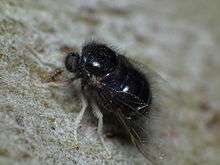Acroceridae
| Small-headed flies | |
|---|---|
 | |
| Pterodontia sp. fly | |
| Scientific classification | |
| Kingdom: | Animalia |
| Phylum: | Arthropoda |
| Class: | Insecta |
| Order: | Diptera |
| Suborder: | Brachycera |
| Infraorder: | Asilomorpha |
| Superfamily: | Nemestrinoidea |
| Family: | Acroceridae |
| Subfamilies | |
| Synonyms | |
| |
The Acroceridae are a small family of odd-looking flies. They have a hump-backed appearance with a strikingly small head, generally with a long proboscis for accessing nectar. They are rare and not widely known. The most frequently applied common names are small-headed flies or hunch-back flies.[1] Many are bee or wasp mimics. Because they are parasitoids of spiders, they also are sometimes known as spider flies.
Description

The Acroceridae vary in size from small to fairly large, about the size of large bees, with a wingspan over 25 mm in some species. As a rule, both sexes have tiny heads and a characteristic hump-backed appearance because of the large, rounded thorax.
In appearance, they are compact flies without major bristles, but many species have a bee-like hairiness on their bodies, and some are bee or wasp mimics. In most species, the eyes are holoptic in both sexes, the heads seemingly composed mainly of the large faceted eyes. This is in contrast to many insects in which the males have larger (even holoptic) eyes, whereas the females have normal eyes. The squamae are disproportionately large, completely covering the halteres and the abdomen has an inflated appearance, often practically globular.[2]The tarsi are equipped with large claws with three pulvilli below them.
Taxonomy
The Acroceridae Leach, 1815, are a small family in the Brachycera. They are members of the infraorder Muscomorpha and DNA studies suggest that they are most closely related to the families Nemestrinidae and Bombyliidae.[3] Morphological data from 2013 suggest the Acroceridae are a sister group to Asiloidea and Eremoneura.[4] The roughly 520 species are placed in 50 genera.
Of the traditionally recognised subfamilies, the Panopinae and Philopotinae appear to be monophyletic, but the Acrocerinae are polyphyletic.[5]
Obsolete synonyms for Acroceridae include Cyrtidae, Oncodidae, and Ogcodidae.
Distribution and habitat
Acroceridae are cosmopolitan in distribution, but nowhere abundant. They appear episodically and in most places are rarely observed; of more than 500 species described, most are known from fewer than 10 specimens. They occur most commonly in semiarid tropical locations.

Behaviour
As far as is known, all Acroceridae are parasitoids of spiders. They are most commonly collected when a spider from the field is brought into captivity. As in the related families, Bombyliidae and Nemestrinidae, members of the family undergo hypermetamorphosis; the adults do not seek out their hosts; instead, the first-instar larva is a planidium. Females lay large number of eggs, up to 5,000, and after hatching, the planidia seek out spiders. They do not resemble the triungulin of most beetles with a hypermetamorphosis, but do resemble the triungulin of Stylops. The larva can move with a looping movement like a leech or inchworm, and can leap several millimetres into the air. When a spider contacts an acrocerid planidium, the planidium grabs hold, crawls up the spider's legs to its body, and forces its way through the body wall, usually at an articulation membrane. Often, it lodges near a book lung,[2] where it may remain for years before completing its development. Mature larvae pupate outside the host.
The adults of most species, like various members of the Tabanidae, Nemestrinidae, and Bombyliidae, are nectar feeders with exceptionally long probosces, sometimes longer than the entire body length of the insect. Unlike the other families, however, when not deploying the proboscis for feeding, the Acroceridae carry it lengthwise medially beneath the body, instead of projecting forward. As a result, the proboscis might escape casual notice, though careful inspection may reveal it projecting slightly behind the abdomen.

Flies are usually found in isolated numbers on plants in July and August in the Palearctic ecozone.
References
- ↑ Gillung, Jéssica P, Winterton, Shaun L. New genera of philopotine spider flies (Diptera, Acroceridae) with a key to living and fossil genera. Journal Article: ZooKeys 01/2011; doi:10.3897/zookeys.127.1824
- 1 2 Richards, O. W.; Davies, R.G. (1977). Imms' General Textbook of Entomology: Volume 1: Structure, Physiology and Development Volume 2: Classification and Biology. Berlin: Springer. ISBN 0-412-61390-5.
- ↑ Wiegmann, Brian M; Yeates, David K; Thorne, Jeffrey L; Kishino, Hirohisa. Time Flies, a New Molecular Time-Scale for Brachyceran Fly Evolution Without a Clock. Syst. Biol. 52(6):745–756, 2003. ISSN 1063-5157 print / ISSN 1076-836X. Online doi:10.1080/10635150390250965
- ↑ Lambkin, Christine L., et al. "The phylogenetic relationships among infraorders and superfamilies of Diptera based on morphological evidence." Systematic Entomology 38.1 (2013): 164-179.
- ↑ Winterton, Shaun L; Wiegmanna, Brian M; Schlinger, Evert I. Phylogeny and Bayesian divergence time estimations of small-headed flies (Diptera: Acroceridae) using multiple molecular markers. Molecular Phylogenetics and Evolution Volume 43, Issue 3, June 2007, Pages 808–832
Further reading
Species lists
Identification
- Sack, P. 1936. Acroceridae. In: Lindner, E. (Ed.). Die Fliegen der palaearktischen Region 21, pp. 1–36. Keys to Palaearctic species but now needs revision (in German).
- Narchuk, E.P. Family Acroceridae in Bei-Bienko, G. Ya, 1988 Keys to the insects of the European Part of the USSR Volume 5 (Diptera) Part 2 English edition.Keys to Palaearctic species but now needs revision.
- Przemysław Trojan, 1962 Acroceridae in (series) Klucze do oznaczania owadów Polski, 28, 23, 1-17. Muchowki = Diptera, 54/58 Publisher Warszawa : Państwowe Wydawnictwo Naukowe
External links
| Wikimedia Commons has media related to Acroceridae. |
| Wikispecies has information related to: Acroceridae |
- - family description, illustrations
- - Yahoo group includes preliminary bibliography
- Images at Diptera.info
- Images at BugGuide
- Family Acroceridae at EOL
- Acroceridae in Italian
- Wing venation